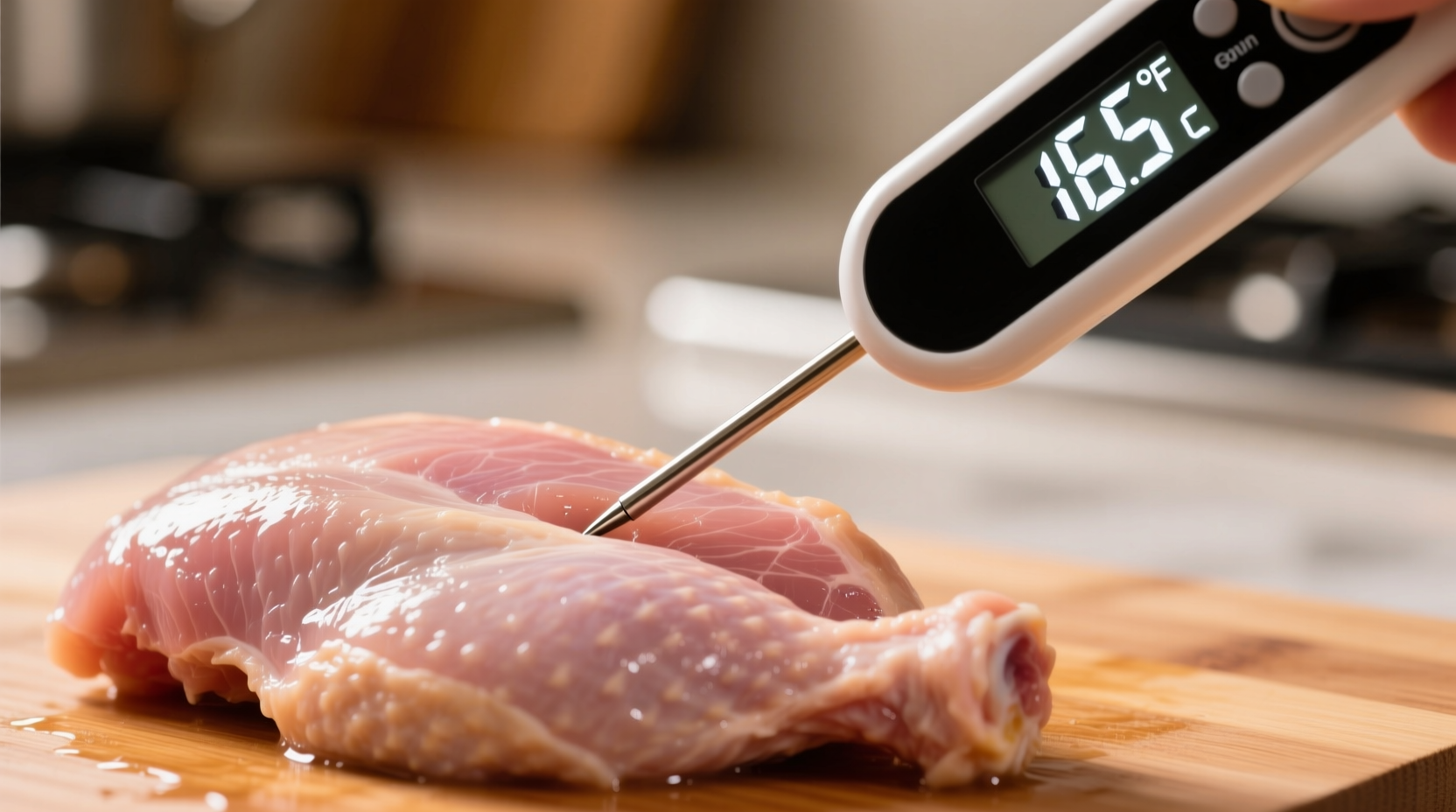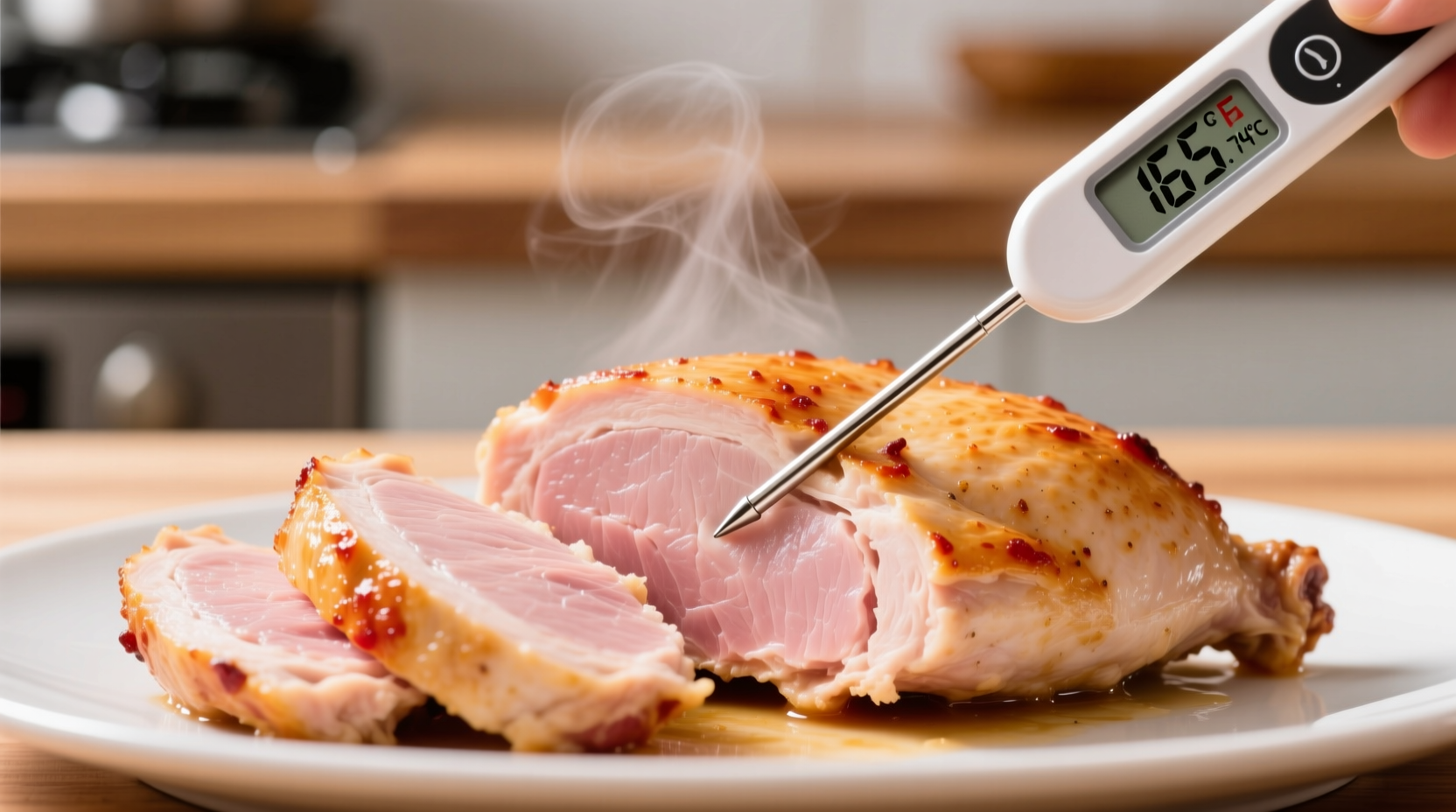The safe internal temperature for cooked chicken is 165°F (74°C) as measured by a food thermometer in the thickest part of the meat. This temperature destroys harmful bacteria like Salmonella and Campylobacter, ensuring your chicken is safe to eat while maintaining optimal texture and moisture.
When preparing chicken at home, getting the temperature right isn't just about doneness—it's a critical food safety requirement. Millions of cases of foodborne illness each year are linked to undercooked poultry, making proper temperature measurement essential for every home cook and professional chef alike.
Why 165°F Is Non-Negotiable for Chicken Safety
Chicken naturally contains harmful bacteria that can cause serious illness if not properly eliminated during cooking. The 165°F (74°C) threshold represents the precise temperature at which pathogens like Salmonella and Campylobacter are instantly destroyed. This scientific standard comes from extensive research by food safety authorities worldwide.
Unlike visual cues like color or texture, which can be misleading, a food thermometer provides the only reliable method to verify chicken has reached a safe temperature. The USDA Food Safety and Inspection Service (FSIS) emphasizes that chicken must reach 165°F regardless of cooking method—whether roasted, grilled, fried, or cooked sous vide.
How to Measure Chicken Temperature Correctly
Proper thermometer technique makes all the difference in accurate temperature readings:
- Use the right thermometer: Digital instant-read thermometers provide the most accurate results for chicken
- Insert in the thickest part: Avoid bones, fat, or gristle which can give false readings
- Check multiple spots: Especially for larger pieces like whole chickens or turkey breasts
- Clean between readings: Prevent cross-contamination by sanitizing your thermometer
For bone-in pieces, insert the thermometer into the meat closest to the bone. When checking ground chicken patties, measure from the center. Remember that temperature continues rising 5-10 degrees during resting, so remove chicken from heat just before it reaches 165°F.
| Chicken Type | Safe Temperature | Resting Time |
|---|---|---|
| Whole Chicken | 165°F (74°C) | 15-20 minutes |
| Breasts/Thighs | 165°F (74°C) | 5-10 minutes |
| Ground Chicken | 165°F (74°C) | 3-5 minutes |
| Stuffed Chicken | 165°F (74°C) in both meat and stuffing | 15-20 minutes |
Temperature Evolution: How Food Safety Standards Developed
Food safety recommendations for chicken have evolved significantly over time as our understanding of pathogens improved:
- 1970s: Recommendations focused primarily on visual doneness cues
- 1980s: First thermometer-based guidelines emerged at 180°F for whole birds
- 1990s: Temperature lowered to 170°F as research showed lower temps were effective
- 2006: USDA standardized 165°F for all poultry products based on pathogen death rates
- Present: 165°F remains the universal standard supported by FDA, CDC, and global food safety organizations
This progression reflects increasingly precise scientific understanding of bacterial death rates at specific temperatures. The current standard balances safety with quality—preventing both foodborne illness and overcooked, dry chicken.

Common Temperature Misconceptions Debunked
Several persistent myths about chicken doneness can lead to unsafe practices:
- "Clear juices mean it's done" - Blood can appear pink even at safe temperatures due to myoglobin
- "White color indicates safety" - Chicken can appear white but still be under 165°F internally
- "Restaurants serve chicken at lower temps" - Legitimate establishments follow the same 165°F standard
- "Boneless chicken cooks faster" - Density matters more than bone presence for temperature rise
The FDA Food Code explicitly states that visual indicators alone cannot verify poultry safety. Only a properly calibrated thermometer provides the necessary verification that chicken has reached a safe internal temperature.
Special Considerations for Different Cooking Methods
While the target temperature remains constant, different cooking techniques require specific approaches:
- Sous vide: Can cook at lower temperatures (145-150°F) for extended periods, but must follow precise time/temperature tables
- Smoking: Must still reach 165°F internally despite lower ambient temperatures
- Grilling: Watch for flare-ups that can char exterior while interior remains undercooked
- Oven roasting: Use a probe thermometer for continuous monitoring of larger birds
For sous vide cooking specifically, the FDA requires maintaining chicken at 145°F for at least 8.5 minutes to achieve the same pathogen reduction as the instant kill at 165°F. This precision cooking method demands strict adherence to time-temperature relationships.
Essential Thermometer Selection Guide
Not all thermometers deliver equal accuracy for chicken preparation:
- Dial thermometers: Require proper calibration and slow reading (30+ seconds)
- Instant-read digital: Most reliable for chicken (reads in 2-5 seconds with ±0.5°F accuracy)
- Oven-safe probes: Good for roasting but less precise for quick checks
- Disposable indicators: Less reliable for precise chicken temperature verification
Regular calibration is essential—test your thermometer in ice water (should read 32°F/0°C) or boiling water (212°F/100°C at sea level). The National Center for Home Food Preservation recommends calibrating thermometers before each use when cooking poultry.
What to Do When Chicken Isn't Reaching Safe Temperature
If your chicken isn't reaching 165°F within expected cooking time, consider these factors:
- Cold spots in cooking equipment: Check oven or grill temperature accuracy
- Overcrowded cooking surface: Prevents proper heat circulation
- Incorrect thermometer placement: Verify you're measuring the thickest part
- Unexpectedly thick pieces: May require extended cooking time
Never guess or estimate doneness. If chicken hasn't reached 165°F, continue cooking and recheck every 2-3 minutes until the safe temperature is achieved. Remember that carryover cooking during resting adds 5-10 degrees, so remove chicken from heat at 160-162°F for optimal results.
Food Safety Beyond Temperature: Comprehensive Protection
While temperature is critical, complete chicken safety requires multiple precautions:
- Proper thawing: Never thaw at room temperature—use refrigerator, cold water, or microwave methods
- Cross-contamination prevention: Use separate cutting boards for raw chicken
- Hand hygiene: Wash hands thoroughly after handling raw poultry
- Cleaning protocols: Sanitize all surfaces that contact raw chicken
The CDC reports that proper cooking temperature eliminates the final barrier to pathogens, but safe handling throughout the preparation process creates multiple layers of protection against foodborne illness.











 浙公网安备
33010002000092号
浙公网安备
33010002000092号 浙B2-20120091-4
浙B2-20120091-4